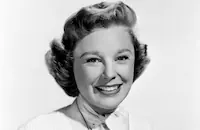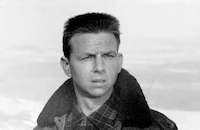Battle Circus

Brief Synopsis
Cast & Crew
Richard Brooks
Humphrey Bogart
June Allyson
Keenan Wynn
Robert Keith
William Campbell
Film Details
Technical Specs

Synopsis
At a mobile Army surgical hospital in war-torn South Korea, nurse Lt. Ruth McCara, who has just transferred in from Tokyo, reports for duty moments before a bombing raid. While risking her life trying to move wounded soldiers, Ruth is intercepted by Maj. Jed Webbe, the wry, pragmatic chief surgeon. The unit is ordered to move to a new location that night, and when Ruth sees the tents come down, she naively assumes that the war must be over. The other nurses wearily begin packing and explain that the hospital moves when the front lines do, adding that they have moved seven times in the last few weeks. Later, during the evacuation, Jed makes a pass at Ruth, but she rebuffs him good-naturedly.
At the new site, the company sets up the camp with great speed and efficiency, and Jed resumes his campaign to win Ruth over. Later, while giving inoculations to South Korean refugees, Ruth finds a child who has been badly wounded by shrapnel. Jed operates, and when the boy's heart stops, performs open-heart massage and saves him. Jed's skill impresses Ruth and she begins to warm to him, but informs the amorous doctor that she will only consider a serious relationship that leads to marriage. Although Jed shows no interest in settling down, Ruth soon falls in love with him, and is crestfallen when another nurse jealously speculates that Jed may already be married. Ruth tries to question Jed about his civilian life, but he refuses to tell her anything.
Later that night, as fierce winds whip through the camp, Jed learns that helicopter pilot John Rustford, who is delivering much-needed blood to the unit, has left the air base without enough fuel. He sets up an improvised landing strip some distance from camp, and John and the blood arrive safely. Jed celebrates by getting drunk in his tent, and Lt. Col. Hillary Whalters, the unit commander, is outraged. The next morning, Whalters tells Jed he must swear to abstain from alcohol, threatening to court-martial him if he gets drunk again. Ruth asks Whalters for a transfer to another unit, but Whalters, aware of Ruth's feelings for Jed, advises her to adopt more aggressive tactics instead. That night, Ruth takes Jed for a drive, and he tells her that he was married but his wife left him for another man. Later, at the hospital, a group of wounded North Korean prisoners are brought in, and one becomes hysterical with fear and produces a concealed grenade. Stifling her own terror, Ruth speaks soothingly to the man and manages to disarm him.
The next day, the unit has just received evacuation orders when the camp is bombed, and both Whalters and Ruth are injured. With no time to pack up the tents, Jed and his men set fire to them, then form a convoy to transport the patients to the base hospital. Jed bids Ruth goodbye, promising to find her again, and sets out on the perilous mission. When guerrilla attacks close the road, Jed orders his men to unload the patients, drive each vehicle down the side of the steep hill and carry the wounded downhill in their arms. Finally, the arduous task is completed, and when the weary cavalcade reaches the nurses on the side of the road, Ruth and Jed are joyfully reunited.

Director

Richard Brooks
Cast

Humphrey Bogart

June Allyson

Keenan Wynn

Robert Keith

William Campbell
Perry Sheehan
Patricia Tiernan
Adele Longmire
Jonathan Cott
Ann Morrison
Helen Winston
Sarah Selby
Danny Chang
Philip Ahn

Steve Forrest

Jeff Richards
Dick Simmons
Sam Mckim
Joe Keane
John Tuggle
Richard [dickie] Tyler
Robert Beard
Roger Mcgee
Rolland Morris

Robert Carson
Arthur Space
Wen Ti Chang
Ted Jordan
Robert Van Orden
Howard Negley
Richard D. Zelechower M.d.
Alex Milstein M.d.
Josh Fields M.d.
Dick Landry
William Self

Alvy Moore
Ralph Ahn
Michael Galloway
Jim Cronan
Leo Needham
Bob Nichols
Patrick Allen
John Sheffield
Tom Walker
Mickey Mccardle
Patrick Lee Holmes
Victor Desny
Roger Etienne Everaert
Tony Layng
Elsie Chew
Jamshid Sheibani
Steve Mitchell
William Yip
Crew
John Alton
James Basevi
Pandro S. Berman
George Boemler
Richard Brooks
Lt. Mary Couch
Cedric Gibbons
A. Arnold Gillespie
Lennie Hayton
Al Jennings
Lee Katz
Laura Kerr
John Nickolaus Jr.
William Orr
William Riley
Allen Rivkin
Douglas Shearer
Alfred E. Spencer
William Thomas
William Tuttle
Lt. Col. K. E. Van Buskirk
Edwin B. Willis

Photo Collections
Videos
Movie Clip



Trailer
Film Details
Technical Specs

Articles
Battle Circus
Tagline for Battle Circus
Desire bit the dust when Humphrey Bogart teamed with one of his unlikeliest co-stars, June Allyson, for his only MGM film. It's not that Battle Circus was a complete failure but the trailers for the 1953 film inadvertently described two films, sending mixed signals with the line "Allyson in love; Bogart in action."
Hollywood didn't make many films about the Korean War during that conflict, and the best contemporary treatment of it was probably Samuel Fuller's low-budget The Steel Helmet (1951), released through independent Lippert Pictures. Clearly, the war was ripe for big-budget Hollywood treatment when MGM green lighted this production, written and directed by Richard Brooks. Brooks had befriended Bogart while co-writing the screenplay to Key Largo (1948) and later had directed him in the newspaper drama Deadline - U.S.A. (1952). With the leading role a cynical Army surgeon trying to protect his patients from both sides of the war while being forced to move his MASH (Mobile Army Surgical Hospital) unit with each change in the front line, he naturally turned to the star, who was intrigued by the script's mordant humor.
When it came time to choose the actress to play his love interest, an idealistic nurse who quickly develops the stamina to survive in war and win the cagy surgeon's heart, something went wrong. Bogie's wife, Lauren Bacall, might have been a great choice. Her throaty voice matched well with his cynical growl, and the two had struck sparks together in To Have and Have Not (1944), the film that made her a star. But she was pregnant at the time with their second child and involved in a series of battles with her studio, Warner Bros., so she was most likely unavailable. MGM may have hoped to make lightning strike twice by casting Allyson, another husky-voiced star, in the lead. She would later claim the studio wasn't choosing her vehicles well because they thought her name would be enough to sell anything. Actually, her career needed a boost as the maturing actress was trying to replace her "girl next door" image. But playing unconvincing love scenes with Bogart and talking a hysterical enemy soldier into handing over a hand grenade proved to be far out of her range.
For the military scenes, however, the studio did everything right. They hired Col. K.E. Van Buskirk, commander of one of the first MASH units, as technical advisor. In addition to location shooting in Calabasas, California, the studio arranged to shoot at Camp Pickett in Virginia, where the MASH units trained. As an added bonus, Camp Pickett had several helicopters they could lend the studio for the shoot. They were also probably the source of the "enemy" planes that strafe the medical encampment, planes clearly labeled "USAF" on screen.
The completed movie was rather a mess. Critics praised the military scenes, with the New York Times hailing "a commendably graphic tribute to American combat valor. For, in depicting the hairbreadth, makeshift operations of one of these heroic units, channeling its precious cargo to safety under constant exposure to the enemy, director Richard Brooks has done a dandy job. Indeed, some of these scenes of frenzied mechanization, detailing the picturesque and the authentic, deserve a straight documentary packaging." Most, however, lambasted the love story as a concession to standard Hollywood filmmaking that killed the film's pace.
Bogart's consolation for the botched mash-up of romance and war drama was his $250,000 fee. That more than compensated him for setting his thumb on fire, an accident easy to spot in the film and its trailer when he's forced to burn his papers during a hasty retreat. Besides, he got better reviews than his co-star, so Battle Circus did little to detract from the string of inspired characterizations that marked much of his work in the 1950s, including his Oscar®-winning performance in The African Queen (1951) and his Oscar®-nominated work in The Caine Mutiny (1954). For Allyson, the reviews were more disheartening. She would only make one more film under her MGM contract before leaving, disappointed that promised roles in The Long, Long Trailer (1953) and I'll Cry Tomorrow (1955) were being given to other actresses.
Hollywood's major studios would rarely return to the Korean War as viable subject matter until 1970, when Robert Altman's M*A*S*H captured some of the insanity of running a surgical unit so close to the battlefield. The two films have an ironic connection. MGM's publicists announced that the title Battle Circus was chosen to refer to the circus-like tents the troops had to hastily move during the war. Before that, however, they made Brooks change his original title, claiming that if the film were called MASH 66, it would make audiences think not of wartime romance, but of potatoes.
Producer: Pandro S. Berman
Director-Screenplay: Richard Brooks
Based on a story by Allen Rivkin, Laura Kerr
Cinematography: John Alton
Art Direction: James Basevi, Cedric Gibbons
Music: Lennie Hayton
Cast: Humphrey Bogart (Maj. Jed Webbe), June Allyson (Lt. Ruth McGara), Keenan Wynn (Sgt. Orvil Statt), Robert Keith (Lt. Col. Hilary Walters), William Campbell (Capt. John Rustford), Philip Ahn (Korean Prisoner), Steve Forrest (Sergeant), Jeff Richards (Lieutenant), Alvy Moore (Runnker).
BW-90m. Closed Captioning.
by Frank Miller

Battle Circus
Quotes
Trivia
The film originally had a different title but the studio and the director thought that title would mislead audiences, so the title "Battle Circus" was instead chosen. The title that was rejected: "MASH".
Notes
The working title of this film was MASH 66. The order of names in the opening cast credits differs slightly from the order of the end credits. According to a Los Angeles Examiner news item, the film's title refers to the ability of mobile field hospital units to dismantle and set up their giant tents as quickly as circuses. An article in Hollywood Citizen-News adds that technical advisor Col. K. E. Van Buskirk had commanded one of the first MASH units in Korea. Portions of the film were shot on location in Calabasas, CA, and Camp Pickett, VA. A New York Times news item states that Camp Pickett was chosen because it was actually a training site for MASH units, and could make helicopters available for the production.
The experiences of medical personnel working at the front lines in the Korean War were also the basis for the unrelated 1970 film M*A*S*H (see AFI Catalog of Feature Films, 1961-70) and the popular television series of the same name, which ran on the CBS network from 1972-83.

Miscellaneous Notes
Released in United States January 1953
Released in United States May 20, 1992
Released in United States on Video May 20, 1992
Released in United States Winter January 1953
b&w
Released in United States January 1953
Released in United States Winter January 1953
Released in United States May 20, 1992
Released in United States on Video May 20, 1992














